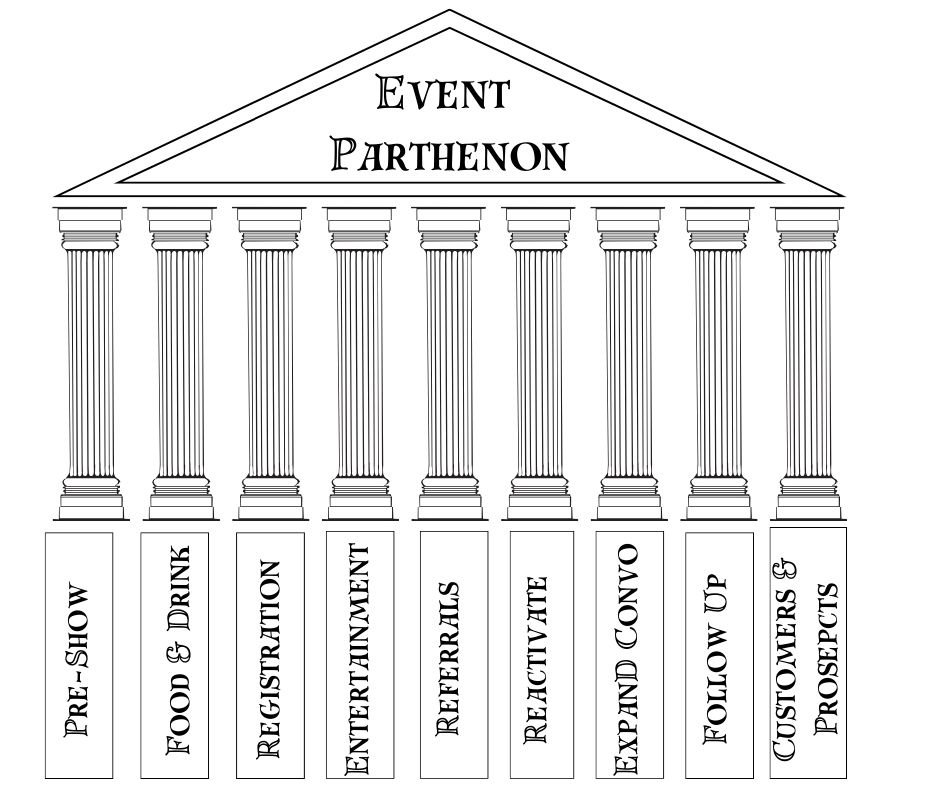The Event Parthenon
If you want to grow the return on investment of any event, this could be the most potent concept you’ll ever learn.
In his book, The Sticking Point Solution, Jay Abraham described two schools of business thought.
The first was the Diving Board School of Business. Much like a diving board is only supported by one pillar on one end of the board, many businesses only have one or two ways of generating business. Typically, their events work the same way. They invite people to come, have a drink and food, and listen to music.
The result is predictable - people who want to have a complimentary drink and a bite to eat while they listen to some music. They show up, eat, drink, listen to music, and go home. Their sales team might try to start conversations with the people there, but not much business is being done.
There has to be a way to structure a stronger event that produces a higher return on investment. Influenced by ancient Greece, Abraham suggests that the Parthenon might be a better metaphor for building your event.
The Parthenon has a heavy stone-framed roof, but the weight is distributed over dozens of strong marble pillars. Each pillar does its work, and the event isn’t dependent on one pillar to do all the work. That’s why the Parthenon still stands on the Acropolis, even though it’s nearly 3000 years old.
Abraham suggests modeling your business and your event on the Parthenon. We already have many pillars that support our events:
registration,
follow-up process
invitation process
sales process
referral process
entertainment
food and beverage
gifts and prizes
transportation.
Each of these processes is dedicated to supporting your event and accomplishing your event’s goals.
Abraham points out, however, that many of these pillars support your event’s objectives in several ways. For instance, entertainment can support your event in at least 13 different ways:
attract people to the event
start referral conversations before, during, and after the event
keep guests at the event rather than going to competitor’s event
differentiate the company’s event from a competitor’s event
help reps and executives start conversations at the event
help guests start conversations with other guests and make the event an “industry hub.”
drive traffic to trade show boot the next day
help guests start conversations about the company the next day, week, month
mention or introduce new products or technology
introduce or highlight key executives
attract guests to future events
help start follow-up conversations after the event
help set appointments during the event
The more systems you combine at the event, the easier it is to achieve the desired result. While the diving board was trying to accomplish all of its goals with just music and refreshments, the Event Parthenon has systems for attracting people to the event, entertainment that creates referrals, setting follow-up appointments, and showcasing new products.
How you choose your entertainment, registration process, sales process, event staff, etc, will determine how effective and resilient your Event Parthenon is.
Each of those systems can have multiple pillars supporting it.
For instance, the entertainment provides 5 different ways for guests to talk about your event, plus five things that can start referral conversations. Your entertainer is driving traffic to your trade show booth while introducing your salespeople and executives to the customers at the event, and you’ve got a stack of existing systems for collecting contact information and setting follow-up appointments - it’s a safe bet you’ll have more conversations with potential customers before, during, and after the event.
Obviously, not every entertainer has a system to achieve these goals; in fact, most only have a system for doing their “thing.” A band plays music, setting your event’s tone and mood. Still, it doesn’t really do anything to support your other business objectives.
This can have a compounding effect over time. Rather than generating conversations through one method, the event might have dozens of methods. Once the conversations are started, the event might have several different systems for what happens after the conversation, ranging from “sending literature” and “making a follow-up call” to “scheduling a meeting at the trade show booth” or “scheduling a full discovery call.”
More and better appointments lead to more sales, and each new sale leads to conversations that keep the existing business, expand the existing business, increase purchase frequency, and generate referrals.
Rather than growing linearly, where one sale begets another sale, an Event Parthenon event can generate dozens of new sale opportunities that generate five or more additional sales.
Jay Abraham calls this geometric growth. As you compound events on top of each other and host the events year after year, the geometric growth looks more like exponential growth.
It’s exciting when you think about it.
Nonetheless, it brings back the same questions every time:
What vendors are in your Power Parthenon, and how are they helping you achieve your event’s goals and objectives?
How many ways can your current vendors help you achieve your goals?
If they haven’t adjusted and adapted their services to help you achieve your goals, do you think it’s because they don’t know how to help you or simply don’t want to help you?
If you’re open to a conversation, call Mike at (561) 596 3877 or visit MagicMeansBusiness.com/contact to set an appointment.


